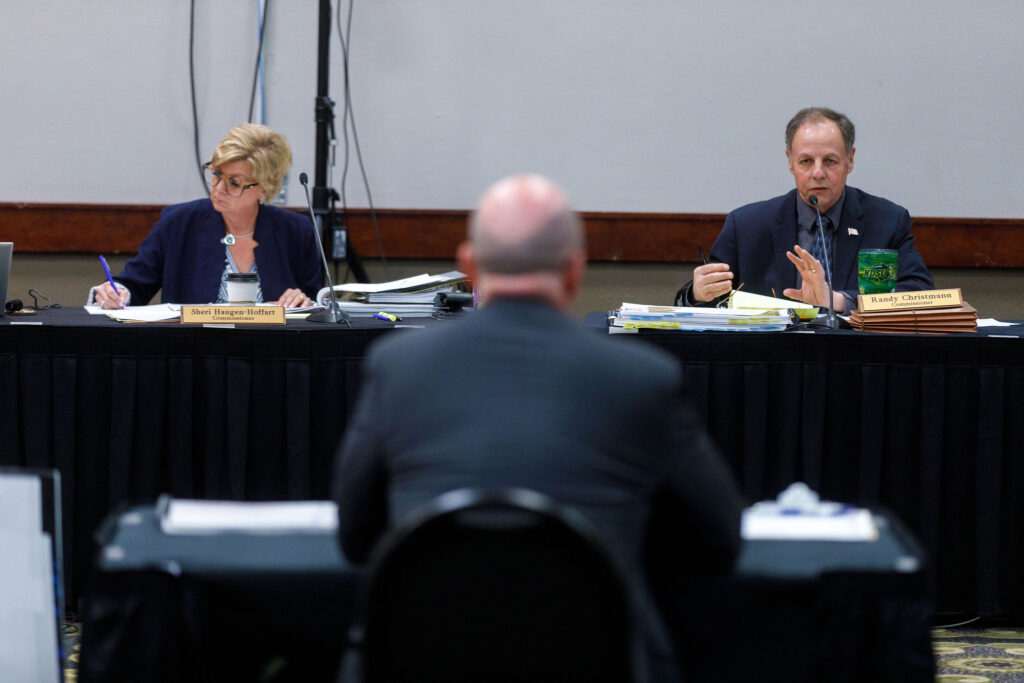North Dakota Public Service Commission Chair Randy Christmann, right, asks questions April 22, 2024, during a public hearing on the Summit Carbon Solutions pipeline. At left is Commissioner Sheri Haugen-Hoffart. (Photo by Kyle Martin for the North Dakota Monitor)
Two attorneys involved in the Summit Carbon Solutions case in North Dakota have differing opinions on the state law that could allow the pipeline developer to use eminent domain.
North Dakota Public Service Commission attorney Zack Pelham said this week that a recent state Supreme Court decision has established that Summit Carbon Solutions has the right to use eminent domain and force landowners to provide right-of-way for its carbon capture pipeline.
Brian Jorde, an attorney for landowners fighting the pipeline, said a ruling on eminent domain, which would give Summit a powerful tool in negotiations, would only come from Summit taking a landowner to court.
Eminent domain allows projects that provide a public benefit to force landowners to sell land or provide an easement that provides right-of-way, also known as condemnation. Landowners are compensated under eminent domain.
Attorney Brian Jorde argues Dec. 18, 2023, to the North Dakota Supreme Court on behalf of landowners in a case involving the state’s survey access law. (Photo by Kyle Martin for the North Dakota Monitor)
Jorde, an attorney based in Nebraska, said in an email to the North Dakota Monitor the North Dakota Supreme Court did not rule on common carrier status.
“Common carrier would most appropriately be challenged when and if Summit were to file a condemnation lawsuit against any North Dakota landowner,” Jorde said. “The trial court made it clear landowners have the ability to challenge the factual basis of the common carrier allegation in any eminent domain proceeding.”
Some landowners in North Dakota have testified in PSC hearings that they have been threatened with eminent domain by Summit representatives.
Pelham said common carrier status is covered under North Dakota Century Code 49-19.
Pelham said Summit Carbon Solutions has filed its acceptance of the provisions of North Dakota law that covers eminent domain and has agreed to follow those rules.
The case considered by the state Supreme Court combined the case of Morton County landowner Howard Malloy with that of several other landowners who argued that Summit should not have access to survey their land without written permission.
Pelham said an order at the district court level determined that Summit was a common pipeline carrier.
In the Malloy decision from the North Dakota Supreme Court, Pelham said there’s a footnote that states landowners have not challenged on appeal that Summit is able to use eminent domain and condemnation.
In his email, Jorde cited Century Code 49-19-11 that says for common carrier status, a pipeline “will accept, carry, or purchase, the oil, coal, gas, or carbon dioxide of the state or of any person not the owner of any pipeline, operating a lease or purchasing oil, coal, gas, or carbon dioxide at prices and under regulations to be prescribed by the commission.”
Jorde said the PSC has not set prices or price regulations for carrying carbon dioxide in North Dakota.
Pipeline siting and property rights rules vary in the five states that are part of the Summit project – Iowa, Minnesota, Nebraska, North Dakota and South Dakota.
Summit is seeking to build a carbon capture pipeline through the five states, ending at a permanent underground storage site northwest of Bismarck. The network of pipelines would collect carbon emissions from 57 ethanol plants, including one in North Dakota, taking advantage of federal tax credits for carbon capture and sequestration.
The Iowa Utilities Commission has granted Summit a permit, giving the company the power of eminent domain, though the pipeline still faces legal challenges. The Iowa permit does not allow Summit to proceed with construction until it has permission to build in the Dakotas.
Republican lawmakers call Summit pipeline approval an ‘attack on the constitution’
The South Dakota Supreme Court ruled in August that Summit has not yet proven it is a common carrier that can use eminent domain. Landowners who oppose the project hailed the decision as a victory, but the company said it will go back to lower courts to prove its case.
Summit says it has obtained more than 80% of the land it needs in North Dakota for its proposed pipeline route through voluntary easements. Some landowners have testified that they only negotiated a voluntary easement because they did not want to fight eminent domain in court.
As the Summit siting case in North Dakota has dragged on, PSC Chair Randy Christmann has noted that the PSC has no authority over the use of eminent domain.
The three-member PSC is conducting work sessions so that it can review rules and testimony regarding Summit’s pipeline route permit application.
The PSC last year denied Summit’s route permit application but allowed the company to make changes to its route. A decision on the altered application is pending.
The PSC tentatively set the next Summit work session for 9 a.m. Oct. 7.

